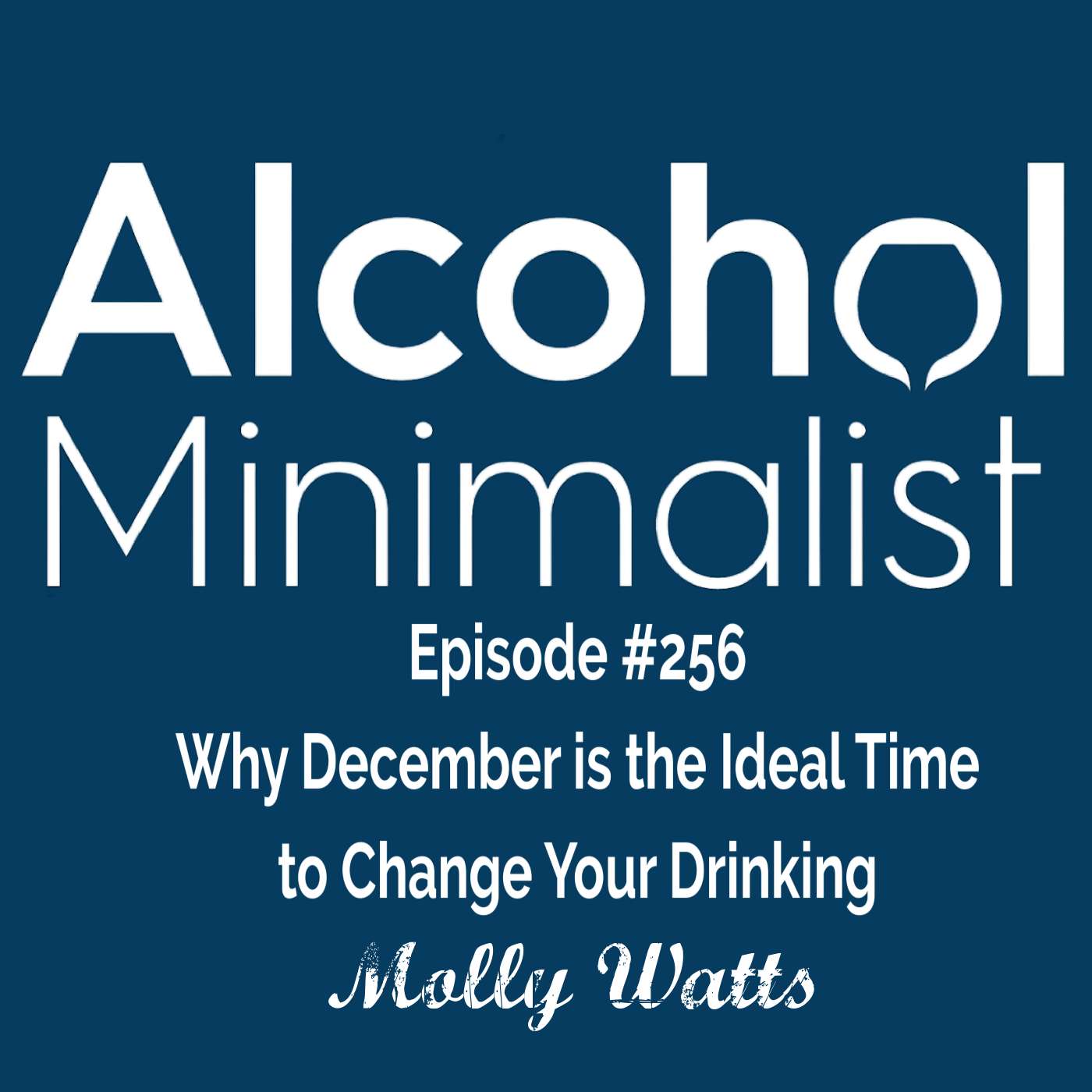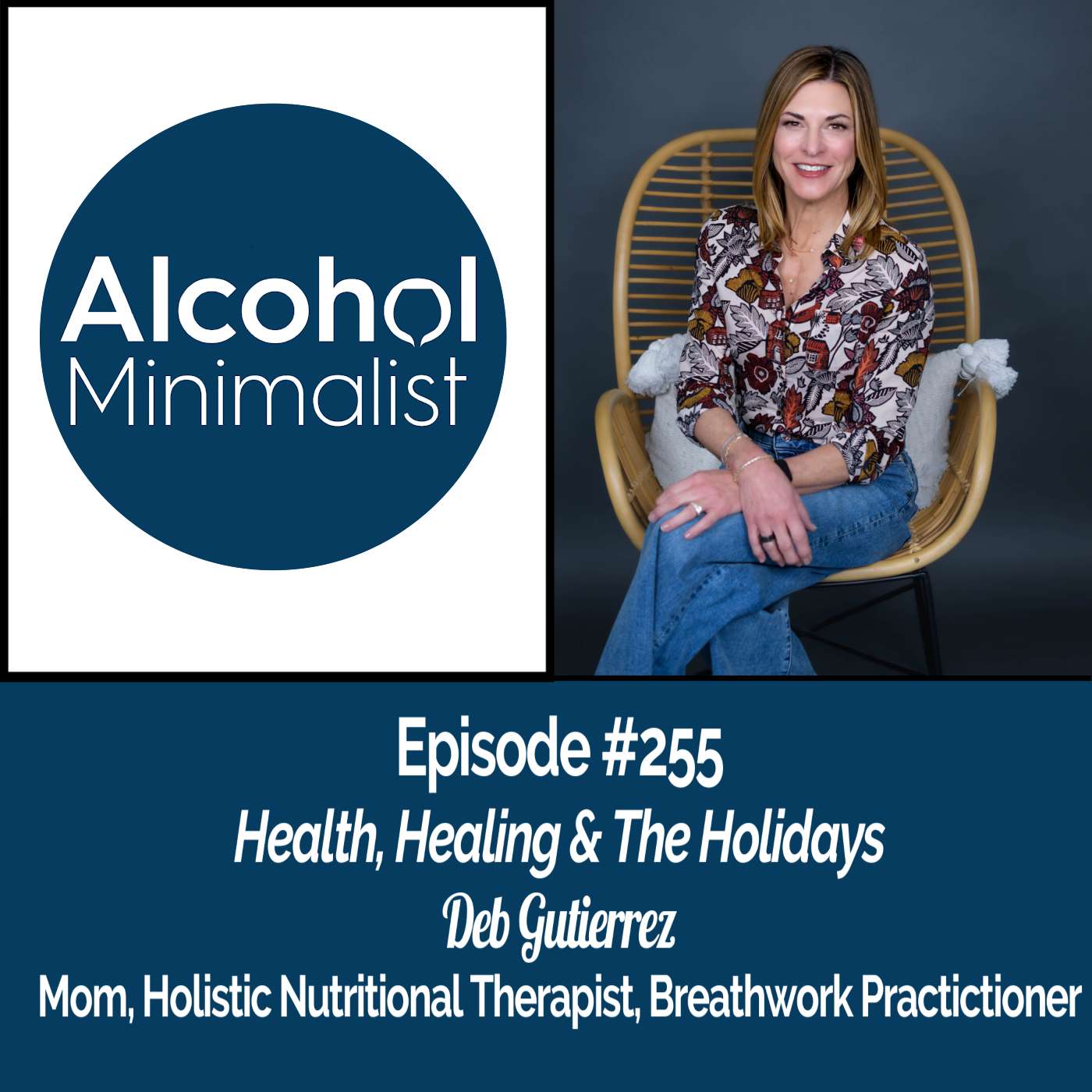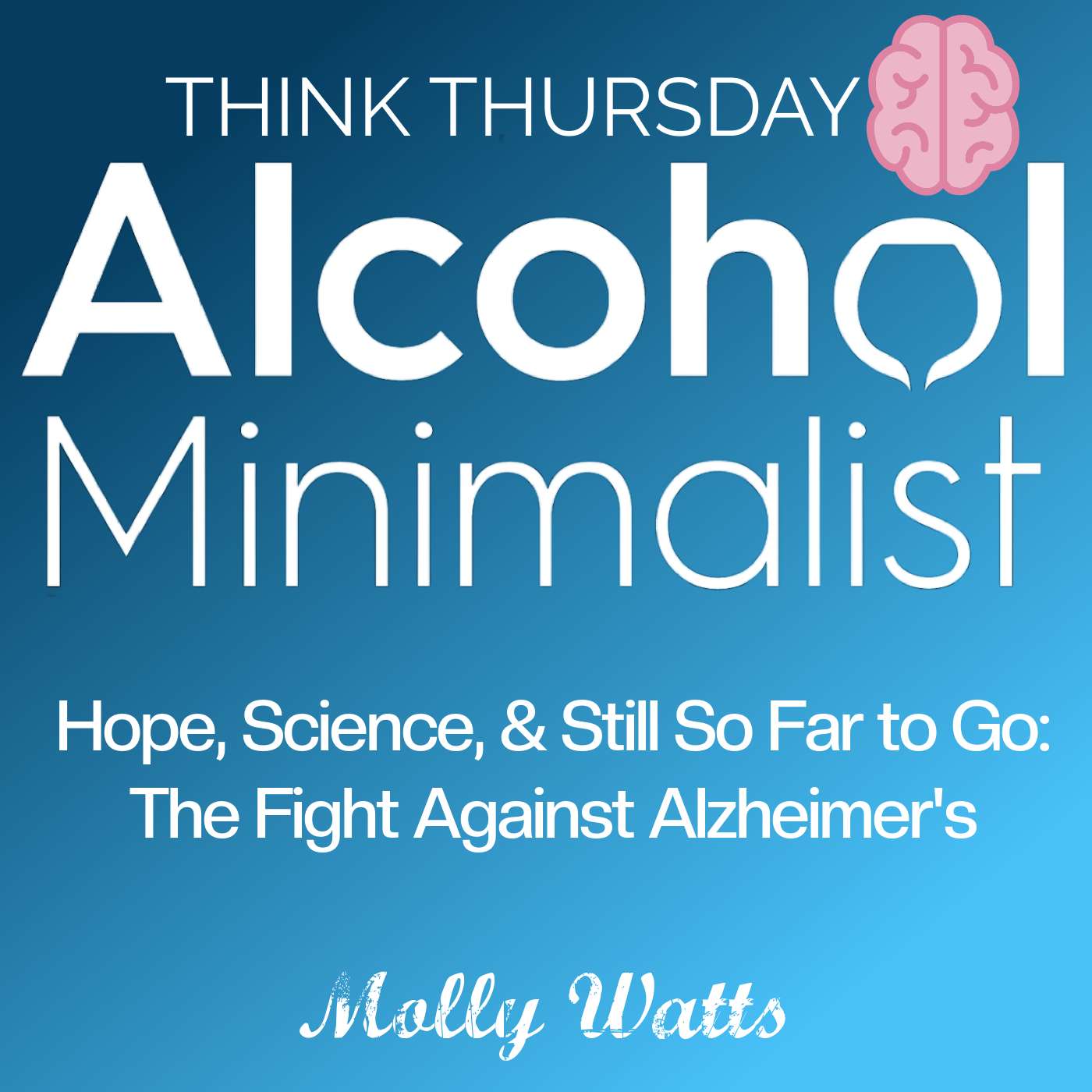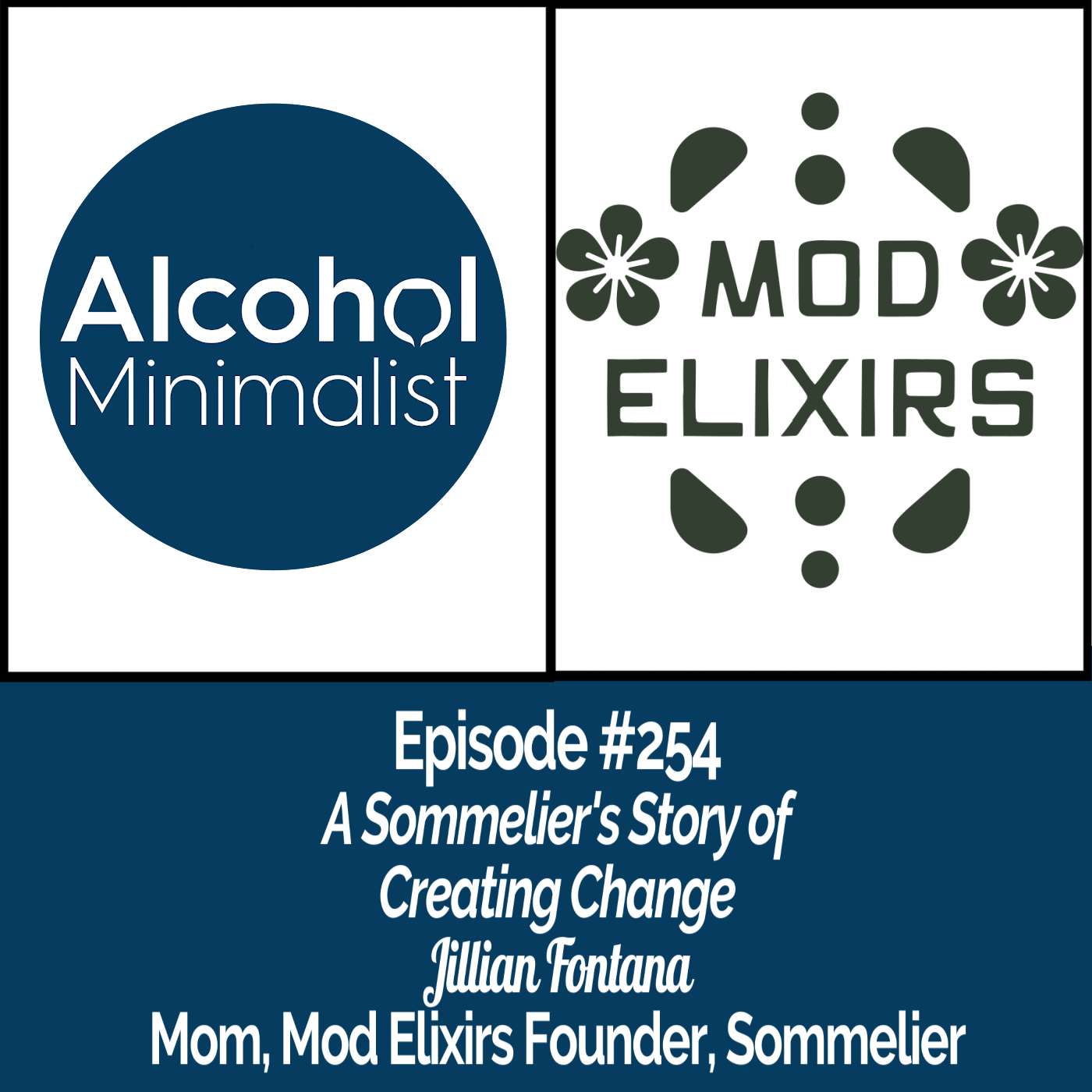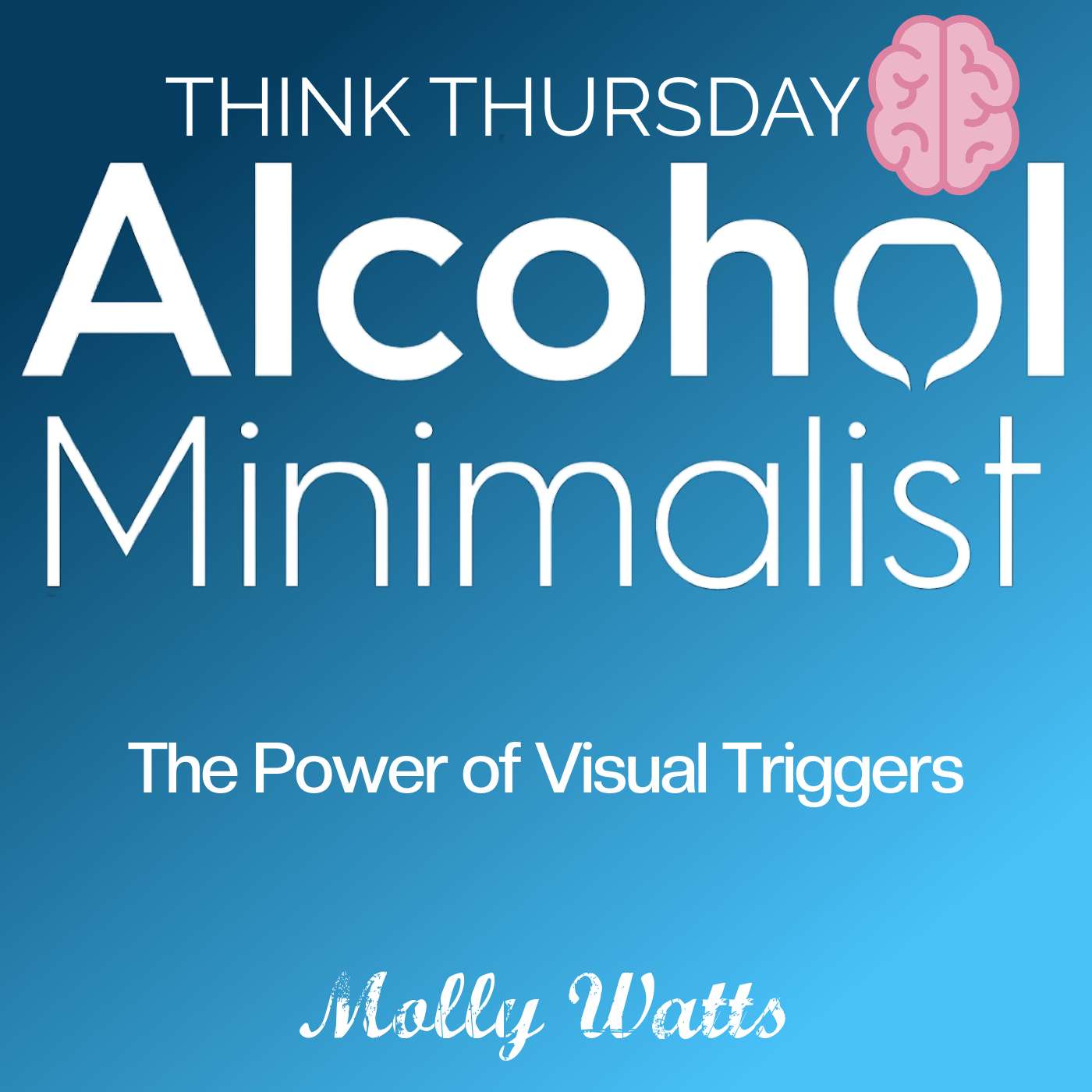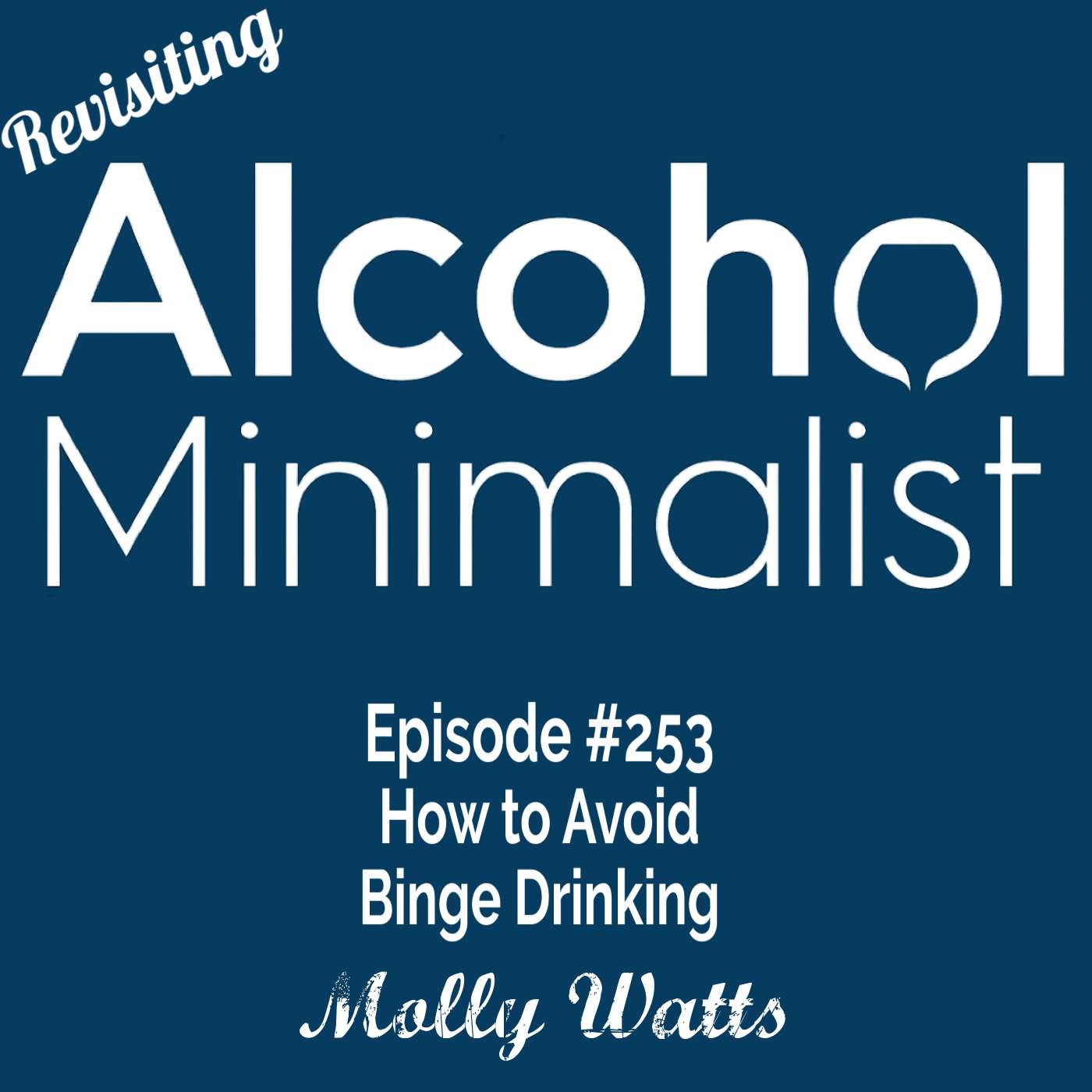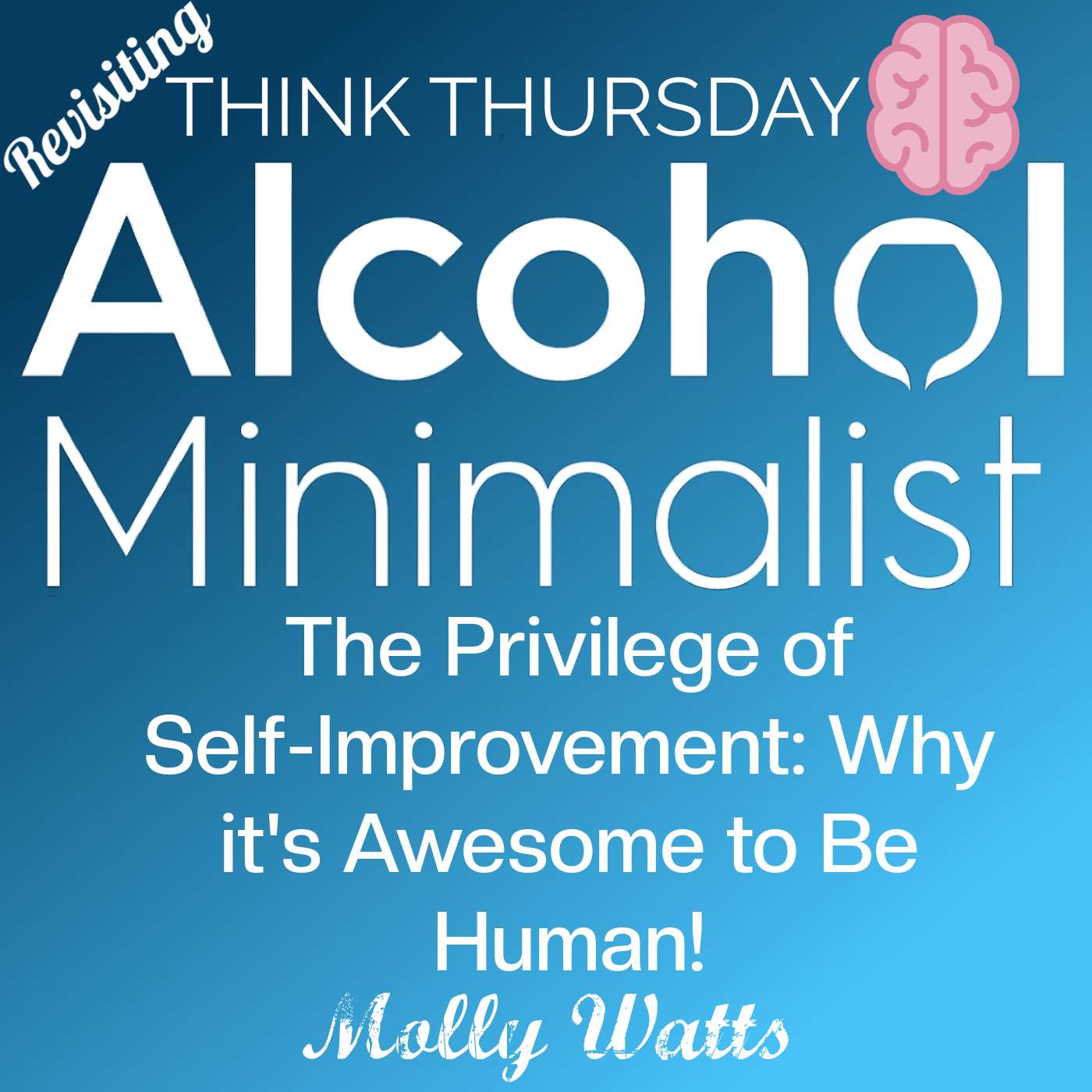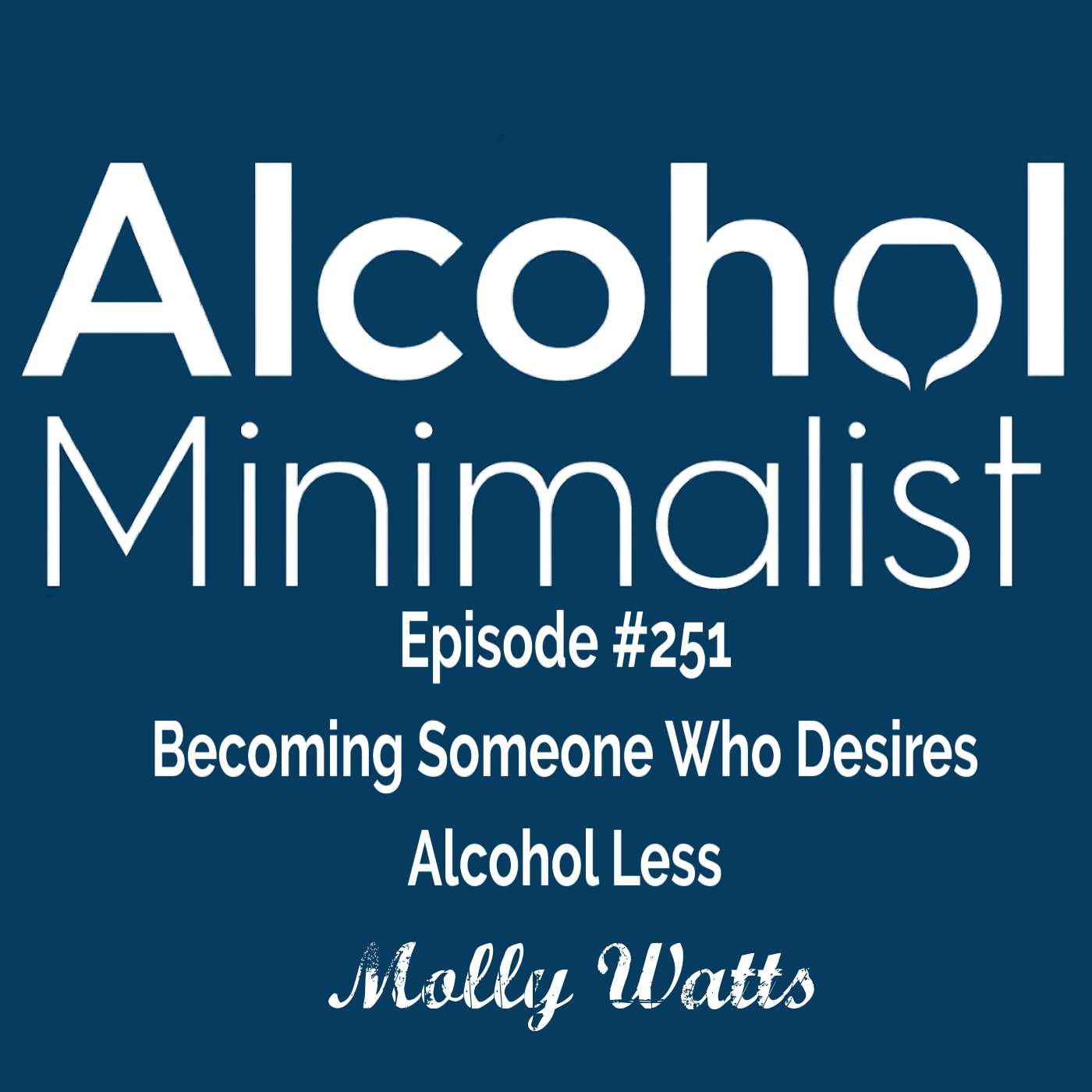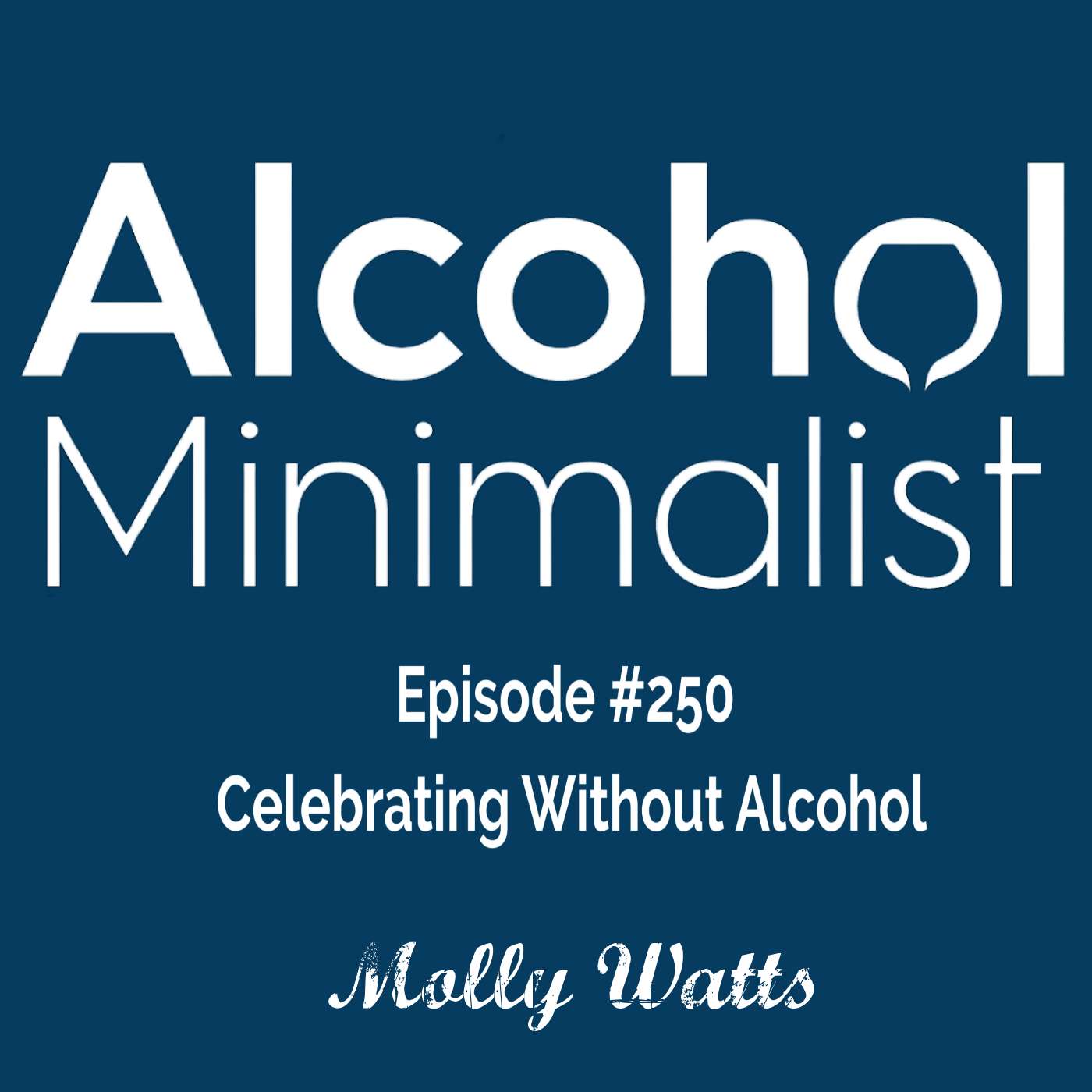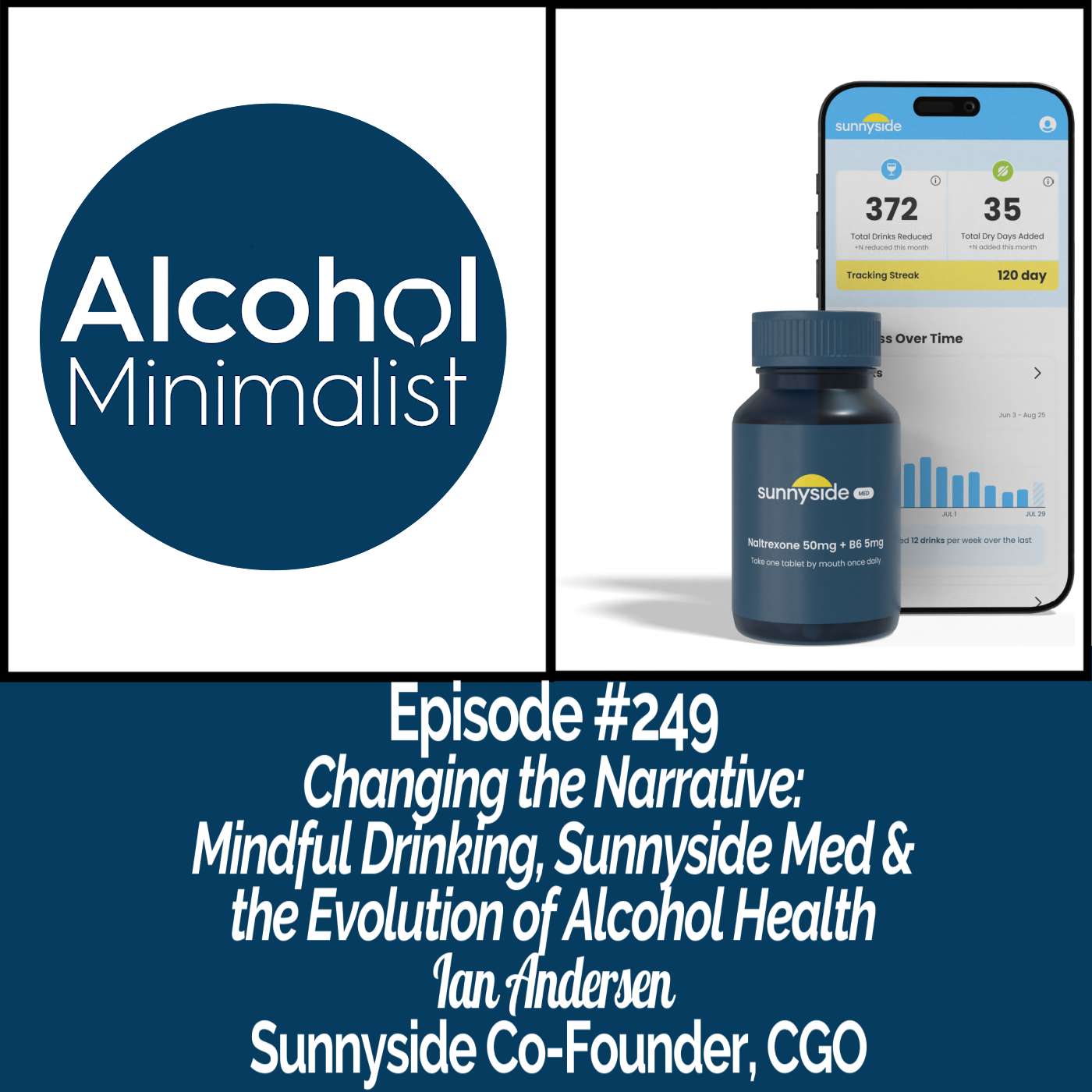Discover Alcohol Minimalist: Change Your Drinking Habits!
Alcohol Minimalist: Change Your Drinking Habits!

Alcohol Minimalist: Change Your Drinking Habits!
Author: Molly Watts, Author & Coach
Subscribed: 172Played: 9,504Subscribe
Share
©2023
Description
Change your relationship with alcohol without shame, guilt, or going sober. Join science-based coach Molly Watts to break habits and find peace through mindful drinking.
Hosted by author and coach Molly Watts, this show is for daily habit drinkers, adult children of alcoholics, and anyone stuck in the “gray area” of alcohol use.
Each episode blends neuroscience, behavior change psychology, and real-world strategies to help you build peace with alcohol — past, present, and future.
You’re not broken. You’re not powerless. You just need new tools.
Less alcohol. More life. Let’s do it together.
New episodes every Monday & Thursday.
Becoming an alcohol minimalist means:
Choosing how to include alcohol in our lives following low-risk guidelines.
Freedom from anxiety around alcohol use.
Less alcohol without feeling deprived.
Using the power of our own brains to overcome our past patterns and choose peace.
The Alcohol Minimalist Podcast explores the science behind alcohol and analyzes physical and mental wellness to empower choice. You have the power to change your relationship with alcohol, you are not sick, broken and it's not your genes!
This show is intended for educational purposes and does not constitute medical advice. If you are physically dependent on alcohol, please seek medical help to reduce your drinking.
Hosted by author and coach Molly Watts, this show is for daily habit drinkers, adult children of alcoholics, and anyone stuck in the “gray area” of alcohol use.
Each episode blends neuroscience, behavior change psychology, and real-world strategies to help you build peace with alcohol — past, present, and future.
You’re not broken. You’re not powerless. You just need new tools.
Less alcohol. More life. Let’s do it together.
New episodes every Monday & Thursday.
Becoming an alcohol minimalist means:
Choosing how to include alcohol in our lives following low-risk guidelines.
Freedom from anxiety around alcohol use.
Less alcohol without feeling deprived.
Using the power of our own brains to overcome our past patterns and choose peace.
The Alcohol Minimalist Podcast explores the science behind alcohol and analyzes physical and mental wellness to empower choice. You have the power to change your relationship with alcohol, you are not sick, broken and it's not your genes!
This show is intended for educational purposes and does not constitute medical advice. If you are physically dependent on alcohol, please seek medical help to reduce your drinking.
329 Episodes
Reverse
If you’re working to change your drinking habits and create a peaceful relationship with alcohol, you’re in the right place. In today’s episode, we revisit a very special conversation with internationally renowned neuropsychopharmacologist, Dr. David Nutt.This episode originally aired when the podcast was still called Breaking the Bottle Legacy, but the message and insights are just as powerful—and relevant—today.In this episode, Molly speaks with Dr. David Nutt, author of Drink? The New Science of Alcohol and Your Health. The conversation dives into the science behind alcohol’s impact on the brain and body, while also exploring how to make more informed, intentional choices about drinking.Dr. Nutt shares:Why he wrote Drink?, and why science must inform our alcohol decisionsThe duality of alcohol: pleasure and poisonHis personal journey with alcohol, including owning a wine bar while being a leading voice in alcohol harm reductionHow using science can help you assess the role of alcohol in your life and your long-term goalsWhy This Episode MattersMolly revisits this conversation as a holiday-season reminder: it’s possible to enjoy social events with alcohol while staying aligned with your goals. Dr. Nutt emphasizes the power of planning ahead, staying self-aware, and not drinking alone—core pillars of the Alcohol Minimalist approach.If you’re seeking peace with alcohol—not necessarily abstinence—this episode delivers practical insights and validation that change is possible when you lead with knowledge and intention.Resources MentionedBook: Drink? The New Science of Alcohol and Your Health by Dr. David NuttWebsite: mollywatts.comTakeawaysAlcohol is a drug—understanding that fact is key to moderation“Think about drink”: intentionality and self-reflection help you stay in controlYou can challenge past patterns and create a new story for yourselfSubscribe and Share If this episode resonated with you, please subscribe and share it with a friend. And if you have a favorite adjective for your weather report or a show guest you’d love to hear from, email Molly at molly@mollywatts.comLow risk drinking guidelines from the NIAAA:Healthy men under 65:No more than 4 drinks in one day and no more than 14 drinks per week.Healthy women (all ages) and healthy men 65 and older:No more than 3 drinks in one day and no more than 7 drinks per week.One drink is defined as 12 ounces of beer, 5 ounces of wine, or 1.5 ounces of 80-proof liquor. So remember that a mixed drink or full glass of wine are probably more than one drink.Abstinence from alcoholAbstinence from alcohol is the best choice for people who take medication(s) that interact with alcohol, have health conditions that could be exacerbated by alcohol (e.g. liver disease), are pregnant or may become pregnant or have had a problem with alcohol or another substance in the past.Benefits of “low-risk” drinkingFollowing these guidelines reduces the risk of health problems such as cancer, liver disease, reduced immunity, ulcers, sleep problems, complications of existing conditions, and more. It also reduces the risk of depression, social problems, and difficulties at school or work.
★ Support this podcast ★
In this episode, Molly explores why holiday creativity is far more than a nostalgic pastime. New research highlighted in The Washington Post shows that engaging in creative activities, even at a beginner level, is associated with younger looking brains and stronger cognitive health.Molly explains how creative acts like crafting, drawing, baking and building stimulate multiple brain networks, reduce stress hormones, and support emotional regulation.She connects these findings to childhood holiday memories while discussing why those early creative experiences were neurologically important. Molly also shares how creativity can support habit change by providing a healthy reward pathway, reducing urges, and strengthening identity. The episode ends with simple, low pressure ideas for tapping into creativity during the holiday season.What You’ll LearnWhy creativity often feels counterintuitive but is deeply supported by neuroscienceHow creative activities activate the motor cortex, prefrontal cortex, reward system and the default mode networkThe connection between creativity, reduced cortisol, and emotional regulationWhy childhood crafting strengthened attention, fine motor skills and dopamine pathwaysHow creativity supports behavior change and identity transformationWhy the holiday season is a perfect time to reconnect with play and creative explorationSimple, nostalgic creative ideas that help the brain settle and feel groundedKey Ideas from the EpisodeYou do not need talent to benefit from creativity; beginners gain the same cognitive advantagesThe brain responds to the creative process, not the quality of the final productHoliday crafts from childhood created sensory, emotional and learning experiences that supported brain developmentCreativity provides a self-generated way to shift emotional states and manage urgesCreative acts reengage curiosity, novelty and presence, which help the holidays feel richer and less overwhelmingSmall creative behaviors can be a meaningful substitute for less helpful coping habitsPractical Creative Ideas MentionedMake a paper snowflakeTry a salt dough ornamentDecorate a gingerbread house kitMake a single handmade holiday cardPaint pinecones with simple suppliesCreate a photo collage from the yearDo a puzzle or coloring pageTreat cooking as a creative actTry a new recipe or texture-based food projectRelated Think Thursday EpisodesThe Paradox of FreedomNovelty for Habit ChangeDefensive PessimismThe Neuroscience of Mental RestSilence Is GoldenBrain Time: Why the Mind Does Not Experience Minutes the Way the Clock Does
★ Support this podcast ★
If your brain is telling you, “It’s the holidays, I’ll start in January,” this episode is here to challenge that script. Molly dives into why the belief that we need a perfect time to change our drinking is one of the most misleading and damaging patterns we fall into. In this episode, you’ll discover why December is actually the ideal time to begin changing your relationship with alcohol—and how doing so can help you build real-life skills that stick.Drawing from neuroscience, behavior science, and lived experience, Molly shows you how to bypass the perfectionism trap and gain momentum before the new year even begins.What You’ll LearnWhy “I’ll start after the holidays” is a psychological trapThe science of temporal discounting and how it sabotages habit changeHow to work with your brain’s neuroplasticity to make change easierWhy starting now creates more resilient, long-term resultsPractical tools to begin moderating your drinking todayFeatured ConceptsHabit change during high-stress seasonsReal-life application of the Behavior Map-Results CycleBuilding skills in real time vs. waiting for “perfect” conditionsEmbracing discomfort as part of sustainable behavior changeQuote to Remember“If you wait for life to calm down to make a change, you’ll be waiting forever. Change happens when you decide it does—even in December.” – Molly WattsLow risk drinking guidelines from the NIAAA:Healthy men under 65:No more than 4 drinks in one day and no more than 14 drinks per week.Healthy women (all ages) and healthy men 65 and older:No more than 3 drinks in one day and no more than 7 drinks per week.One drink is defined as 12 ounces of beer, 5 ounces of wine, or 1.5 ounces of 80-proof liquor. So remember that a mixed drink or full glass of wine are probably more than one drink.Abstinence from alcoholAbstinence from alcohol is the best choice for people who take medication(s) that interact with alcohol, have health conditions that could be exacerbated by alcohol (e.g. liver disease), are pregnant or may become pregnant or have had a problem with alcohol or another substance in the past.Benefits of “low-risk” drinkingFollowing these guidelines reduces the risk of health problems such as cancer, liver disease, reduced immunity, ulcers, sleep problems, complications of existing conditions, and more. It also reduces the risk of depression, social problems, and difficulties at school or work.
★ Support this podcast ★
In this special revisited Thanksgiving edition of Think Thursday, Molly reflects on the transformative power of gratitude—how it can reshape your mindset, elevate your mood, and even improve your physical health. Originally aired in 2024, this episode has become a listener favorite for the Thanksgiving holiday and beyond.With both scientific insight and personal reflection, Molly shares why gratitude is more than a seasonal tradition. It's a practice with real, measurable impact on your brain, your emotions, and your long-term well-being.In This Episode, You’ll Learn:How gratitude impacts your brain and supports long-term change through neuroplasticityResearch from Dr. Robert Emmons showing gratitude's connection to greater joy, optimism, and emotional resilienceThe link between gratitude and physical health—lower cortisol levels, improved sleep, reduced inflammation, and stronger immunityWhy a simple gratitude journal can decrease depression and increase happiness in as little as 10 weeksWhat the "gratitude-happiness loop" is and how to use it to shift your mindsetMolly’s personal story of loss, healing, and why Thanksgiving is an especially meaningful time for reflectionScience Spotlight:Functional MRI scans show that gratitude activates the medial prefrontal cortex, a key area of the brain related to learning, decision-making, and reward processingRegular gratitude practice can literally reshape neural pathways, strengthening more positive emotional responses over timeKey Quote:“Gratitude is like a superpower we all have—but we rarely use it to its full potential.”Resources and Mentions:Gratitude episode of Live Happier Longer Related episode: The Gap and The Gain, focused on reframing your perspective toward growth and appreciationResearch references to Dr. Robert Emmons’ work on gratitude and positive psychologyIdeal For:Listeners dealing with grief, family tension, or emotional overwhelm during the holidaysAnyone interested in how mindset shapes behavior and long-term changePeople seeking science-based strategies to increase happiness and well-being
★ Support this podcast ★
In this heartfelt and empowering conversation, Molly Watts welcomes Deb Gutierrez, a seasoned nutritional therapist and friend of the show. Deb shares her powerful story of surviving a life-threatening health crisis and how it reshaped her approach to wellness from the ground up.Deb’s experience with endocarditis and open-heart surgery forced her to surrender control in ways she never expected. Her story offers a vivid reminder of why foundational habits—like moving your body, getting sunlight, and yes, minimizing alcohol—are critical not only for longevity but for resilience.Together, Molly and Deb explore the importance of honoring your body, the long-term impact of nutritional and lifestyle choices, and how to stay connected to your "why" when making change.Whether you're rethinking your relationship with alcohol or looking for inspiration to prioritize your health, this episode delivers hope, science-backed insight, and practical wisdom. What You'll Learn:Why foundational habits like movement, sleep, and morning light matter deeplyThe surprising diagnosis that led to Deb’s open-heart surgery—and her recovery journeyHow surrendering control became Deb’s most empowering lessonWhy "being built for it" isn't just about physical fitness, but mental and emotional readinessHow alcohol fits into a whole-person view of long-term healthWhy your habits today are either compounding problems or investing in resilienceResources & Links:Connect with Deb Gutierrez: www.debghealth.comLearn more about creating a peaceful relationship with alcohol at www.mollywatts.com Featured Quote:“Minimizing alcohol is a foundational health habit—just like sleep, movement, and nutrition. These are the basics that build resilience when life throws the unexpected your way.” — Molly WattsLow risk drinking guidelines from the NIAAA:Healthy men under 65:No more than 4 drinks in one day and no more than 14 drinks per week.Healthy women (all ages) and healthy men 65 and older:No more than 3 drinks in one day and no more than 7 drinks per week.One drink is defined as 12 ounces of beer, 5 ounces of wine, or 1.5 ounces of 80-proof liquor. So remember that a mixed drink or full glass of wine are probably more than one drink.Abstinence from alcoholAbstinence from alcohol is the best choice for people who take medication(s) that interact with alcohol, have health conditions that could be exacerbated by alcohol (e.g. liver disease), are pregnant or may become pregnant or have had a problem with alcohol or another substance in the past.Benefits of “low-risk” drinkingFollowing these guidelines reduces the risk of health problems such as cancer, liver disease, reduced immunity, ulcers, sleep problems, complications of existing conditions, and more. It also reduces the risk of depression, social problems, and difficulties at school or work.
★ Support this podcast ★
In this Think Thursday episode, we're diving into a subject that touches millions of lives — Alzheimer’s disease.Molly shares recent, promising research on dementia and cognitive decline while weaving in her own powerful experiences from World Alzheimer’s Day at the senior living community where she works.From the beauty of a memorial garden filled with pinwheel tributes to being part of the top fundraising team at the Oregon Zoo Walk to End Alzheimer’s, this episode is both science-forward and deeply personal.You'll hear:The latest neuroscience headlines about dementia preventionWhy music, walking, and sleep are powerful brain-protective toolsWhat current research reveals — and why a cure remains elusiveReal-life stories from a senior living community taking actionWhat you can do today to protect your brain and support the causeKey Takeaways:Daily music engagement — especially singing — may significantly reduce dementia risk.Moderate walking preserves brain function and slows plaque buildup.Circadian rhythm regulation is critical for reducing inflammation and memory loss.Alzheimer’s is a complex condition involving immune response, metabolism, and brain structure — clearing plaques is not enough.Simple, daily habits — paired with community action — can make a powerful difference.Whether you're thinking about your own cognitive future or honoring someone you love, this episode will leave you both hopeful and empowered.
★ Support this podcast ★
In this inspiring episode, Molly welcomes special guest Jillian Fontana, a certified sommelier and founder of Mod Elixirs, a new line of thoughtfully crafted alcohol-free beverages. Jillian shares her personal journey from being fully immersed in the wine and hospitality industry to re-evaluating her relationship with alcohol—all while staying true to her passion for wine and food.Through their conversation, Molly and Jillian explore what it means to be an alcohol minimalist even when you’re deeply connected to the beverage industry. Jillian’s story offers a powerful example of how we can rewrite our beliefs about alcohol, prioritize our well-being, and still celebrate the joy of tasting and pairing in a new way.What You'll Learn in This Episode:How Jillian’s professional identity as a sommelier intersected with her personal struggle around overdrinkingThe subtle but important difference between alcohol moderation and alcohol minimalismWhy redefining rituals and routines around alcohol is a key part of long-term changeHow Jillian used her industry experience to develop Mod Elixirs, a brand-new line of alcohol-free elixirsPractical ways to incorporate mindful drinking while honoring your passion for food, wine, and connectionAbout Jillian Fontana:Jillian is a certified sommelier with a background in high-end restaurants in Boston and New York. After becoming a mother and noticing the increasing role alcohol played in her daily life, she began rethinking her habits and redefining her relationship with drinking. Drawing on her deep knowledge of flavor and pairing, she launched Mod Elixirs—a brand dedicated to crafting complex, delicious, non-alcoholic beverages for those who want a new way to celebrate.Resources & Links:Learn more about Mod Elixirs: Mod Elixirs WebsiteConnect with Jillian Fontana on Instagram: @modelixirsMolly's book: Breaking the Bottle LegacyJoin the Alcohol Minimalist community: Facebook GroupLow risk drinking guidelines from the NIAAA:Healthy men under 65:No more than 4 drinks in one day and no more than 14 drinks per week.Healthy women (all ages) and healthy men 65 and older:No more than 3 drinks in one day and no more than 7 drinks per week.One drink is defined as 12 ounces of beer, 5 ounces of wine, or 1.5 ounces of 80-proof liquor. So remember that a mixed drink or full glass of wine are probably more than one drink.Abstinence from alcoholAbstinence from alcohol is the best choice for people who take medication(s) that interact with alcohol, have health conditions that could be exacerbated by alcohol (e.g. liver disease), are pregnant or may become pregnant or have had a problem with alcohol or another substance in the past.Benefits of “low-risk” drinkingFollowing these guidelines reduces the risk of health problems such as cancer, liver disease, reduced immunity, ulcers, sleep problems, complications of existing conditions, and more. It also reduces the risk of depression, social problems, and difficulties at school or work.
★ Support this podcast ★
In this Think Thursday episode of the Alcohol Minimalist podcast, Molly explores how visual triggers—those subtle, often overlooked cues in your environment—powerfully influence your behavior. Whether it’s a bottle on the counter, a glowing screen, or a browser tab, your brain is constantly scanning for shortcuts and responding to what it sees.Drawing on neuroscience and habit psychology, Molly explains why visual input is processed faster than any other sense and how it becomes tightly linked with repetitive behaviors. More importantly, she offers practical strategies to reduce unwanted visual cues and introduce new ones that support the behaviors you want to reinforce.This episode is for anyone curious about how to work with their brain—not against it—to build healthier, more intentional habits.What You'll Learn:Why your brain processes visual information in just 13 millisecondsHow visual cues trigger automatic behaviors—even before you're aware of themWhat “cue reactivity” is and how it affects desireHow dopamine gets released in anticipation of a reward, not afterReal-world examples of visual triggers you might not be noticingTwo powerful strategies for managing your visual environment intentionallyHow visual design can help you create new habits with less frictionPractical Strategies from the Episode:Remove Visual Triggers You Don’t WantClear counters, put items in drawers, reduce sensory reminders of unwanted habits“Out of sight, out of mind” is more than a phrase—it’s a cognitive toolAdd Visual Cues for Behaviors You Want to ReinforcePlace journals, shoes, or water bottles in visible spots tied to your goalsUse sticky notes or phone screensavers with thought prompts or affirmationsReady to Take the Next Step?Explore Molly’s Drink Less Success 30-day self-starter program—grounded in neuroscience and designed to help you rewire your habits through simple, daily actions. Find the link in the show notes or visit mollywatts.com to learn more.Connect with Molly:Email: molly@mollywatts.comWebsite: mollywatts.comFacebook Group: Alcohol MinimalistInstagram: @alcoholminimalist
★ Support this podcast ★
Episode Summary:In this timely revisited episode of the Alcohol Minimalist Podcast, Molly dives deep into the topic of binge drinking—what it is, how it affects your brain, and most importantly, how to avoid it. In the spirit of No Binge November, Molly reflects on the broader implications of binge behavior across all areas of life, not just alcohol. She challenges long-held assumptions, shares science-backed insights, and offers both mindset shifts and practical tools to help you reduce or eliminate binge episodes.Whether you’ve ever thought, “I’m not a binge drinker,” or you've struggled with black-and-white thinking like, “Once I start, I can’t stop,” this episode provides clarity, context, and encouragement to build a more peaceful, mindful relationship with alcohol.What You’ll Learn in This Episode:Why binge drinking might look different than you thinkThe scientific definition of binge drinking from the NIHHow higher ABV drinks can quietly turn moderate drinking into binge drinkingThe impact of binge drinking on your brain and behaviorMindset patterns that contribute to binge episodesTools and strategies to help you stay mindful and break the cycleKey Takeaways:Binge drinking isn’t just about getting sloppy drunk—it can be more subtle, and many daily drinkers may unknowingly meet the criteria.A typical IPA may pack more alcohol than you realize, impacting your overall intake more than expected.Mindset plays a powerful role—believing "I just can't stop" can become a self-fulfilling prophecy.The goal of being an alcohol minimalist inherently means avoiding binge episodes and embracing calm, controlled drinking habits.Low risk drinking guidelines from the NIAAA:Healthy men under 65:No more than 4 drinks in one day and no more than 14 drinks per week.Healthy women (all ages) and healthy men 65 and older:No more than 3 drinks in one day and no more than 7 drinks per week.One drink is defined as 12 ounces of beer, 5 ounces of wine, or 1.5 ounces of 80-proof liquor. So remember that a mixed drink or full glass of wine are probably more than one drink.Abstinence from alcoholAbstinence from alcohol is the best choice for people who take medication(s) that interact with alcohol, have health conditions that could be exacerbated by alcohol (e.g. liver disease), are pregnant or may become pregnant or have had a problem with alcohol or another substance in the past.Benefits of “low-risk” drinkingFollowing these guidelines reduces the risk of health problems such as cancer, liver disease, reduced immunity, ulcers, sleep problems, complications of existing conditions, and more. It also reduces the risk of depression, social problems, and difficulties at school or work.
★ Support this podcast ★
Welcome back to a revisited edition of Think Thursday from the Alcohol Minimalist Podcast. These Thursday episodes are all about understanding your brain, challenging outdated thought patterns, and using neuroscience to support real, lasting change in your relationship with alcohol.This week, we're bringing back one of the foundational Think Thursday conversations: The Privilege of Self-Improvement. Whether you’re hearing it for the first time or coming back for a refresh, this episode is especially relevant as we approach the end of the year and the start of the holiday season.What You’ll Learn in This Episode:Why self-improvement isn’t a burden, but a privilege uniquely available to humansThe role of your prefrontal cortex in planning, reflection, and long-term behavior changeHow to shift out of the “start over in January” mindset and build momentum nowWhy changing your drinking habits is an act of personal development, not punishmentThe neuroscience behind why your brain can work for you—or against you—and how to make it your allyWhy This Episode Still Matters:Too often, people think change has to wait until a new year, a clean slate, or a big external motivator. But this episode reminds you that the ability to grow, reflect, and choose new actions is one of the most powerful parts of being human. And that process can start today—right where you are.Key Quote:"The very fact that you're capable of imagining a better version of yourself and taking steps to create it is something to celebrate—not dread."Resources:Read the book: Breaking the Bottle Legacy by Molly WattsFree guide: Alcohol Truths — science-based info to guide your choicesLearn about our core programs: Making Peace with Alcohol, Drink-Less Success, and Proof PositiveNew episodes release every Monday and Thursday. If this conversation resonated with you, share it with a friend or leave a review to help others discover the Alcohol Minimalist approach.
★ Support this podcast ★
In this episode of the Alcohol Minimalist podcast, Molly explores how your environment—your physical space, routines, and sensory cues—quietly shapes your drinking habits. From the shape of your glass to the spot you sit in at night, environmental triggers can powerfully reinforce auto-pilot behavior.But here's the key: these external cues are not the full story. They don't create your drinking habit—they support it. Real change comes from understanding why you’re drinking in the first place and learning to respond to that emotional need in a new way.If you’re ready to interrupt automatic drinking patterns and create more space for intention, this episode offers practical experiments and key mindset shifts to help you get started.What You'll Learn:The science behind “cue-induced behavior” and why your brain responds to drinking cues before you even decide to drinkHow physical environments and sensory cues reinforce habit loopsWhy changing your environment won’t change your desire—but can support itFive practical, science-based experiments to reduce drinking triggers and increase awarenessHow to use those experiments as a bridge to deeper internal workThe emotional questions to ask when you interrupt a habit loopWhy lasting change requires more than just tactics—it requires managing your thoughtsExperiments to Try This Week:Swap Your Glass – Use a different shape or style to disrupt routineChange Your Location – Don’t drink in your usual “drinking spot”Clear Visual Cues – Remove bottles, tools, and reminders from sightSwap the Soundtrack – Introduce new music or lighting to shift moodCreate a Wind-Down Zone – Design a new space for tea, reading, or journaling and anchor it to relaxation instead of alcoholLow risk drinking guidelines from the NIAAA:Healthy men under 65:No more than 4 drinks in one day and no more than 14 drinks per week.Healthy women (all ages) and healthy men 65 and older:No more than 3 drinks in one day and no more than 7 drinks per week.One drink is defined as 12 ounces of beer, 5 ounces of wine, or 1.5 ounces of 80-proof liquor. So remember that a mixed drink or full glass of wine are probably more than one drink.Abstinence from alcoholAbstinence from alcohol is the best choice for people who take medication(s) that interact with alcohol, have health conditions that could be exacerbated by alcohol (e.g. liver disease), are pregnant or may become pregnant or have had a problem with alcohol or another substance in the past.Benefits of “low-risk” drinkingFollowing these guidelines reduces the risk of health problems such as cancer, liver disease, reduced immunity, ulcers, sleep problems, complications of existing conditions, and more. It also reduces the risk of depression, social problems, and difficulties at school or work.
★ Support this podcast ★
Your inner critic: that voice in your head that says, “You’re not good enough,” or “You’ll never stick with this.” We all have one. But what if there was a way to take back your power—starting with something as simple (and science-backed) as giving it a name?In this episode of Think Thursday from the Alcohol Minimalist, Molly dives into the neuroscience and psychology behind naming your inner critic and how this deceptively small move can have a big impact on your identity, your habits, and your peace of mind.In this episode:Why self-critical thoughts become default neural pathwaysWhat psychology research tells us about the “self-critic sequence”How naming your inner critic creates psychological distance and disrupts habit loopsThe brain science behind identity-based changeWhat to do when your critic shows up (including journaling prompts and self-compassion techniques)You’ll also hear how Molly uses the phrase “Old Molly” to talk back to her own inner critic—and how this practice can create space for a new self to emerge.This is your brain’s inner dialogue—rewired for growth.Resources Mentioned:Work of Dr. Kristin Neff on self-compassionIdentity-based habits from James ClearPsychology research on emotion naming and self-criticismDialogical Self TheoryYour Think Thursday Challenge:Choose a name for your inner criticSpeak to it with awareness and intentionJournal about the shifts you noticeYou’re not trying to silence the voice—you’re learning how to lead it. And that’s how you move from reaction to intention, and from habit to identity.Subscribe to the Alcohol Minimalist for more episodes like this. And if this resonated with you, share it with someone who’s working on self-talk and habit change.Until next time—choose peace, and choose good thoughts.
★ Support this podcast ★
Episode Summary: As we close out More Sober October, Molly invites you to reflect not just on how many drinks you had—or didn’t have—but on who you became along the way. This episode brings the month’s theme full circle, offering a powerful emotional close and a neuroscience-backed perspective on identity change.Molly revisits the month’s key concepts, including identity scripts, neuroplasticity, and casting “votes” for the kind of person you want to become. You’ll hear encouragement to look beneath the surface of your habits and recognize the deeper shifts that may already be taking place.Whether October went exactly to plan—or not even close—this episode is a celebration of your progress, your resilience, and your values in action.In This Episode, You’ll Learn:Why change often feels subtle—and how that’s a sign it’s workingHow repetition rewires the brain and reshapes identityJames Clear’s insight on identity-based habits and casting votesWhy you don’t need to be perfect to be proudHow to create a powerful future-focused reflection practiceTry This Practice: Write a short letter to your “future you” with these prompts:This is what I’ve learned about myself…This is what I want you to remember next time it gets hard…This is what I’m proud of from More Sober October…This is what I know is possible for you…Bonus Reminder: Change isn’t just about what you believe. It’s about what you remember. Document your growth and create a breadcrumb trail for the future you to follow.Next Steps: Join Molly for No-Binge November, featuring the Just One More? Rewiring the Binge Brain course. For just $39, you’ll receive lifetime access plus two live group coaching calls. Sign up here. Connect with Molly:Website: www.mollywatts.comInstagram: @alcoholminimalistFacebook Group: https://www.facebook.com/groups/alcoholminimalistsLow risk drinking guidelines from the NIAAA:Healthy men under 65:No more than 4 drinks in one day and no more than 14 drinks per week.Healthy women (all ages) and healthy men 65 and older:No more than 3 drinks in one day and no more than 7 drinks per week.One drink is defined as 12 ounces of beer, 5 ounces of wine, or 1.5 ounces of 80-proof liquor. So remember that a mixed drink or full glass of wine are probably more than one drink.Abstinence from alcoholAbstinence from alcohol is the best choice for people who take medication(s) that interact with alcohol, have health conditions that could be exacerbated by alcohol (e.g. liver disease), are pregnant or may become pregnant or have had a problem with alcohol or another substance in the past.Benefits of “low-risk” drinkingFollowing these guidelines reduces the risk of health problems such as cancer, liver disease, reduced immunity, ulcers, sleep problems, complications of existing conditions, and more. It also reduces the risk of depression, social problems, and difficulties at school or work.
★ Support this podcast ★
In this episode of Think Thursday, Molly explores the powerful difference between joy and pleasure, and why understanding this distinction matters for anyone pursuing lasting behavior change — including changing your relationship with alcohol.We often use “joy” and “pleasure” interchangeably, but from a neuroscience lens, they activate different brain pathways and lead to profoundly different emotional outcomes. Pleasure is short-lived, dopamine-driven, and external. Joy, on the other hand, is sustainable, meaning-based, and internally constructed.Molly breaks down the brain science behind each, explaining:Why our reward system is wired for instant gratificationHow dopamine can lead to tolerance (and increased consumption)Why joy isn’t just felt — it’s built and interpreted by the brain’s meaning-making systemShe offers five brain-friendly strategies to create more joy in your life — and how these tools can directly support your alcohol minimalist journey.What You'll LearnThe key neurochemical differences between pleasure and joyWhy pleasure tends to fade quickly (and leave you wanting more)The role of dopamine, serotonin, oxytocin, and endorphins in how we feelWhy joy can be cultivated, even in challenging momentsPractical, science-backed ways to bring more joy into your daily lifeJoy-Building Practices:Savoring – Pause and stretch out positive experiencesGratitude – Practice genuine (not performative) thankfulnessConnection – Strengthen relational bonds in simple waysAligned Action – Do one small thing that reflects your valuesNovelty – Try something new to spark curiosity and attentionMentioned in the Episode:The SPARK acronym from Monday’s main episodeInsights from the book Aesthetics of Joy by Ingrid Fetell LeeWhy This MattersWhen you're changing your drinking habits, it's not about removing pleasure — it's about building something more lasting and meaningful. Understanding how to create joy gives you a powerful tool to replace the quick fix of alcohol with something far more fulfilling.Ready to practice joy on purpose? Start with just one idea from today and notice how it shifts your mindset.
★ Support this podcast ★
Episode Summary:In this episode of the Alcohol Minimalist Podcast, Molly explores a powerful and often overlooked question: Can you truly celebrate without alcohol? As we wrap up More Sober October and gear up for No Binge November, Molly dives into the neuroscience behind celebration and what it means to detach joy from a drink.Drawing on personal insight and scientific research, she challenges the deeply ingrained belief that alcohol is necessary for joy, milestones, or connection. This episode is a reminder that true celebration comes from meaning—not from what's in your glass.What You'll Learn:Why our culture ties alcohol so tightly to celebrationHow to redefine what celebration really meansThe neuroscience of joy and how your brain creates itPractical strategies for celebrating without relying on alcoholThe importance of identity in alcohol change workSpecial Announcement:Molly introduces her limited-time course Just One More? Rewiring the Binge Brain—offered exclusively for No Binge November. This $39 course includes:Lifetime access to the course contentA downloadable workbookTwo live group coaching calls with MollyA community of support to help you stick with your goalsThis is a great opportunity for anyone looking to shift their binge patterns and move into a more peaceful relationship with alcohol.Resources Mentioned:Sign up for No Binge November and the Just One More? course: https://alcoholminimalist.thrivecart.com/just-one-more-no-binge-november/To get email updates about upcoming events and coaching, join Molly's mailing list.Connect with Molly:Website: www.mollywatts.comInstagram: @alcoholminimalistFacebook Group: https://www.facebook.com/groups/alcoholminimalistsLow risk drinking guidelines from the NIAAA:Healthy men under 65:No more than 4 drinks in one day and no more than 14 drinks per week.Healthy women (all ages) and healthy men 65 and older:No more than 3 drinks in one day and no more than 7 drinks per week.One drink is defined as 12 ounces of beer, 5 ounces of wine, or 1.5 ounces of 80-proof liquor. So remember that a mixed drink or full glass of wine are probably more than one drink.Abstinence from alcoholAbstinence from alcohol is the best choice for people who take medication(s) that interact with alcohol, have health conditions that could be exacerbated by alcohol (e.g. liver disease), are pregnant or may become pregnant or have had a problem with alcohol or another substance in the past.Benefits of “low-risk” drinkingFollowing these guidelines reduces the risk of health problems such as cancer, liver disease, reduced immunity, ulcers, sleep problems, complications of existing conditions, and more. It also reduces the risk of depression, social problems, and difficulties at school or work.
★ Support this podcast ★
In this Think Thursday episode, Molly explores why sometimes not knowing can actually make you calmer, more focused, and more creative. Continuing the theme of counterintuitive brain science, she builds on previous Think Thursday episodes like The Paradox of Freedom, Novelty for Habit Change, and last week’s Defensive Pessimism to show how Selective Ignorance helps protect the brain’s limited capacity for attention, energy, and emotion.What You’ll LearnWhy so many principles of neuroscience and psychology feel counterintuitive at firstHow your brain filters 11 million bits of information every second through the reticular activating systemWhy constant news, emails, and notifications drain your mental energyHow dopamine drives curiosity and why too much novelty burns it outWhat studies show about the benefits of “information fasting” and reduced mental inputPractical ways to practice Selective Ignorance to improve focus and reduce stressKey Quotes“The people who make meaningful change aren’t the ones who know the most—they’re the ones who filter the best.” — James Clear, Atomic Habits“Sometimes not knowing helps you know yourself better.” — Molly WattsPractical TakeawaysCurate your inputs. Follow fewer, higher-quality sources.Schedule mental quiet. Set “ignorance hours” for digital silence.Replace input with reflection. Journal, walk, or sit in quiet thought.Remember the enough threshold. Progress comes from applying what you already know, not learning more.Studies and Sources MentionedClear, J. (2018). Atomic Habits – Selective Ignorance and focusLevitin, D. (2014). The Organized Mind – The attention economyStanford University and University of London – Research on multitasking and IQKillingsworth, M. & Gilbert, D. (2010). Science – Mind-wandering and happinessPsychological Science (2015) – Information fasting and creative problem solvingDesimone, R. & Duncan, J. (1995). Annual Review of Neuroscience – The biased competition model of attentionRelated Think Thursday EpisodesDefensive Pessimism—How Planning for the Worst Helps You Do Your BestThe Paradox of FreedomNovelty for Habit ChangeThe Neuroscience of Mental RestSilence Is GoldenNeurodivergence and the Brain’s Energy Economy
★ Support this podcast ★
This week, Molly welcomes back Ian Andersen, co-founder of Sunnyside, for a timely and thought-provoking conversation on the evolving landscape of alcohol health and behavior change. Ian shares the backstory of Sunnyside’s growth from its origins during the pandemic to the recent launch of Sunnyside Med, a new initiative designed to support individuals seeking more structure and support in reducing their alcohol consumption.If you're feeling challenged during “More Sober October,” or you’ve ever felt like you're behind the curve while the media insists everyone is drinking less, this episode offers reassurance, insight, and practical next steps.What You’ll Learn:Why Sunnyside was founded and how its inclusive, non-prescriptive model fills a critical gap in alcohol supportWhat Sunnyside Med is and who it's designed to helpThe disconnect between public alcohol trends and personal strugglesHow the cultural narrative around moderation is evolvingWhy sustainable change requires systems, not shameThe psychological barriers that often prevent progress and how to overcome themQuotable Moments“We don’t want to be the food scale or calorie counter of alcohol. We want to be a guide, not a judge.” – Ian Andersen“Just because the news says people are drinking less, doesn’t mean you feel less stuck.” – Molly WattsResources and LinksLearn more about Sunnyside: www.sunnyside.coGet details on Sunnyside Med: https://www.joinsunnysidemed.com/Visit Molly’s site for courses and coaching: www.mollywatts.comLow risk drinking guidelines from the NIAAA:Healthy men under 65:No more than 4 drinks in one day and no more than 14 drinks per week.Healthy women (all ages) and healthy men 65 and older:No more than 3 drinks in one day and no more than 7 drinks per week.One drink is defined as 12 ounces of beer, 5 ounces of wine, or 1.5 ounces of 80-proof liquor. So remember that a mixed drink or full glass of wine are probably more than one drink.Abstinence from alcoholAbstinence from alcohol is the best choice for people who take medication(s) that interact with alcohol, have health conditions that could be exacerbated by alcohol (e.g. liver disease), are pregnant or may become pregnant or have had a problem with alcohol or another substance in the past.Benefits of “low-risk” drinkingFollowing these guidelines reduces the risk of health problems such as cancer, liver disease, reduced immunity, ulcers, sleep problems, complications of existing conditions, and more. It also reduces the risk of depression, social problems, and difficulties at school or work.
★ Support this podcast ★
This week on Think Thursday, we’re exploring an idea that turns conventional wisdom on its head: defensive pessimism. While it may sound like a negative mindset, it’s actually a powerful, evidence-based cognitive strategy that helps anxious or overthinking brains perform better, reduce stress, and follow through on goals more effectively.Defensive pessimism isn't about catastrophizing or giving up. It's about anticipating obstacles and using those thoughts to prepare instead of panic. In this episode, you'll learn how this approach taps into the brain’s natural tendency to predict outcomes, and how making one critical shift — understanding the difference between prediction and probability — can dramatically improve your results.We’ll talk about:What defensive pessimism is and why it worksThe neuroscience of prediction and how it affects your behaviorWhy your brain’s “what ifs” might be trying to help youA simple three-step process to start using this strategy todayWhether you're trying to build a new habit, overcome self-doubt, or just want to feel more in control of your daily life, this mindset can help you stop overthinking and start planning with confidence.Want more support? Join the Alcohol Minimalist Facebook group or email Molly directly at molly@mollywatts.com. We’d love to hear how you’re using defensive pessimism to create change.
★ Support this podcast ★
In this week’s episode, Molly dives deeper into the More Sober October theme: Who are you without the drink? If you've ever felt like you're at war with yourself when it comes to drinking decisions, you're not imagining it. Molly unpacks the neuroscience behind this inner conflict and introduces listeners to the concept of our two selves—the automatic self and the intentional self.Referencing Daniel Kahneman’s book Thinking, Fast and Slow, Molly breaks down how System 1 (your fast, emotional, habitual brain) and System 2 (your slow, rational, goal-focused brain) influence your drinking choices. This science-backed framework explains why your default drinking habits feel so hard to break and why it’s absolutely possible to rewire your brain to make intentional, value-aligned decisions.Whether you’re navigating more alcohol-free days this October or simply trying to understand why it’s so hard to say no sometimes, this episode offers practical insight and compassionate encouragement.Key Topics CoveredWhy identity and habit formation go hand-in-hand with your drinking storyThe difference between your default (automatic) self and your intentional selfHow Kahneman’s System 1 and System 2 thinking applies to alcohol habitsWhy the brain resists effortful thinking and defaults to the familiarHow to start training your intentional self to become your new defaultResources MentionedBook: Thinking, Fast and Slow by Daniel KahnemanJoin More Sober October with Molly: More Sober October InfoLow risk drinking guidelines from the NIAAA:Healthy men under 65:No more than 4 drinks in one day and no more than 14 drinks per week.Healthy women (all ages) and healthy men 65 and older:No more than 3 drinks in one day and no more than 7 drinks per week.One drink is defined as 12 ounces of beer, 5 ounces of wine, or 1.5 ounces of 80-proof liquor. So remember that a mixed drink or full glass of wine are probably more than one drink.Abstinence from alcoholAbstinence from alcohol is the best choice for people who take medication(s) that interact with alcohol, have health conditions that could be exacerbated by alcohol (e.g. liver disease), are pregnant or may become pregnant or have had a problem with alcohol or another substance in the past.Benefits of “low-risk” drinkingFollowing these guidelines reduces the risk of health problems such as cancer, liver disease, reduced immunity, ulcers, sleep problems, complications of existing conditions, and more. It also reduces the risk of depression, social problems, and difficulties at school or work.
★ Support this podcast ★
In this Think Thursday episode, Molly explores why the brain doesn’t experience minutes the way the clock does. Our perception of time is not fixed—it stretches and compresses depending on novelty, memory, attention, and emotion. That’s why childhood summers feel endless while adulthood years can seem to vanish.Molly unpacks the psychology and neuroscience of time perception, including how prospective and retrospective time work, why novelty sharpens attention and stretches moments, and how emotions like fear, boredom, and joy distort our sense of time. She also shares fascinating phenomena like the “stopped clock illusion” and highlights how mindfulness can expand our sense of presence and create richer memories, making life feel fuller and more meaningful.What You’ll Learn in This Episode:The difference between prospective time and retrospective timeWhy childhood feels longer than adulthoodHow novelty, memory, and dopamine influence time perceptionHow emotions like stress, boredom, and joy distort our experience of timeWhy mindfulness slows down prospective time and lengthens retrospective memorySimple practices to stretch brain time and savor everyday momentsKey Quote:“Clock time is rigid—sixty minutes is always sixty minutes. But brain time is elastic. Two people can live the same number of years yet experience them very differently depending on how much novelty, presence, and emotion they build into their days.”References and Resources:Eagleman, D. (2009). Brain Time: The Temporal Dimension of ExperienceWittmann, M. (2016). Felt Time: The Psychology of How We Perceive TimeConsciousness and Cognition (2019): Mindfulness meditation and time perceptionPrevious Think Thursday episodes: The Power of Reminiscing, The Science of Awe
★ Support this podcast ★




